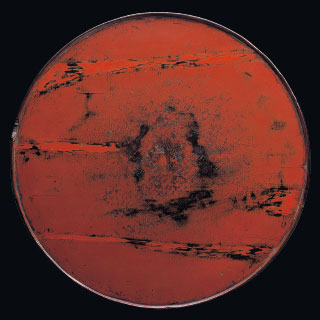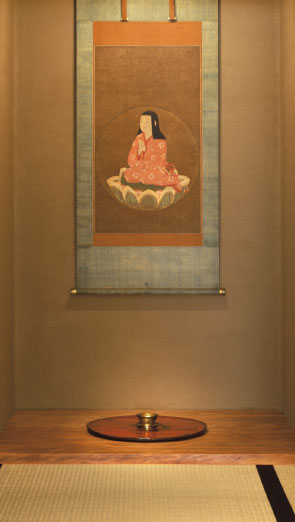|
|
|
|
Japan, Kamakura period,
dated Einin 6 (1298)
D. 42.3–43.2 cm, H. 1.8 cm MIHO MUSEUM |
|
|
Every March (the second month of the lunar calendar), the
ritual commonly known as
Omizutori (also known as Shunie), involving
large
taimatsu torches made of pine branches, is held at
the Nigatsu-dō (the hall of the second month) at Tōdai-ji
Temple in Nara. This tray, known as
Nigatsudō rengyōshū bon ( tray for the secluded monks
of the Nigatsu-dō Hall), was used once a day for meals in
the dining hall below the Nigatsu-dō by the
rengyōshū monks during this ritual. Its popular name,
Hinomaru bon or “Rising Sun Tray,” comes from the
association of its color and shape with the sun.
Early negoro trays from the Kamakura period were eventually dispersed in tumultuous times such as during the anti-Buddhist movement in the early Meiji period (1868–1912). Some even went into private hands. Today, Tōdai-ji Temple has eleven trays, while seven are in the collections of private individuals and museums, suggesting that they were coveted works of art among connoisseurs. This exhibition will feature five of the seven negoro trays that have survived in private collections. |
 |

Mihoko Koyama (1910–2003), the founder of MIHO MUSEUM, collected tea
ceremony utensils for some fifty years. Among her collection is the
Hinomaru Tray. Koyama seemed to enjoy incorporating Buddhist art in
the tearoom as seen in this photo. Here, a painting of the esoteric
Buddhist master Kūkai (774–835) as an acolyte is hung in a
decorative alcove, creating an added sense of stateliness to this
sublime arrangement of utensils.
(*Works will be rotated during the exhibition.)